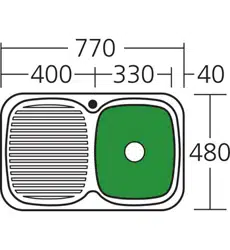Loading ...
Loading ...
Loading ...

The special seal (1) should be placed carefully onto the upper surface of the benchtop, on the edge of the
cut out. Press down on it lightly so that it sticks to the surface Carefully lower the sink into the cut out
and onto the seal. Fasten the mounting brackets (4) to the sink as shown, using the screws provided. Then
tighten the mounting bracket with a screwdriver, making sure that the sink is pulled down towards the
benchtop and compresses the seal (1).
NOTE: Do not overtighten the mounting bracket screws.
Once the sink is installed carefully trim any excess seal from around the sink.
Bolt it to the benchtop using “molly” assemblies. Care must be taken during drilling and tightening to
avoid cracking.
If you have any doubts, confirm the correct mounting method for your material by consulting
the benchtop supplier.
• Avoid placing pots, pans or other hot objects in excess of 280° C on the surface of the sink (CAUTION! The
bottom of a pot or pan just removed from the burner can reach temperatures of over 600°C).
• Pots, pans and other hot objects must be placed on appropriate potholders (made of wood, rubber, etc.).
Avoid causing excessive thermal shock due to the presence of very hot and very cold objects on the sink at
the same time.
• Do not use the sink as a cutting surface: rather, use a cutting board made of hardwood or polyethylene,
which can be purchased together with the sink.
• The use of stainless steel dish baskets or surface protectors (which can be purchased together with the sink)
can reduce the risk of accidental damage.
• Do not use abrasive substances or metal cleaning pads (steel wool) to clean the sink because they scratch
the surface, making it susceptible to stains.
• Heavy or pointed objects that fall on the surface of the sink can damage it.
• Scratches and chips on the surface of the sink can be removed using sandpaper and then a coat of polish.
• CAUTION! Do not pour alcohol, gasoline, trichloroacetic acid or any solvents in general into or onto the sink
because they could react with the chemical structure of the sink and damage it beyond repair.
• Clean the sink regularly after each time it is used with warm water and a liquid detergent and a soft cloth.
Generic stains should be removed immediately.
• Cleaning powders and creams which are even slightly abrasive should not be used, nor chemically aggressive
detergents.
• Marks caused by foods or liquid which stain easily, i.e. tea, coffee, fruit juice and the like, must be removed
immediately with very hot water and a cleaning product.
• Special stains, such as those caused by Indian ink, ink, oil-based stains or paints, etc., must be removed
immediately.
If these stains are difficult to remove, use a cloth dampened with denatured alcohol.
• For organic stains which are especially difficult to remove, it is recommended that you fill the sink with a
highly diluted organic cleaner such as bleach and let stand overnight. The next morning, rinse with warm
water and a soft cloth.
• Lines caused by contact between a pot or fork and the surface of the sink should be removed with a cloth
or sponge and liquid detergent.
1” Counter / benchtop with hole drilled
Molly
Special sealant
Sink flange
Saddle
Screw
© Tasman Sinkware - TF158c Granite Sink Installation Instructions
GRANITE SINK INSTALLATION INSTRUCTIONS
Please retain for consumer as care instructions are included
FOR TOPMOUNT INSTALLATION PRACTICAL ADVICE ON THE CARE AND MAINTENANCE OF THE SINK
OTHER INSTRUCTIONS ON HOW TO CLEAN THE SINK
FOR UNDERMOUNT INSTALLATION
